From Jurassic Park to Walking with Dinosaurs, blockbuster movies usually depict dinosaurs as terrifying beasts.
But, look back just a few hundred years, and this definitely wasn’t the case.
With only a few fragments of bones to guide them, early palaeontologists arrived at some pretty goofy ideas of what dinosaurs may have looked like.
From clumsy creatures resembling scaly rhinos to today’s fearsome feathered beasts, depictions of dinosaurs have changed a lot since their first discovery.
As we celebrate 200 years since the discovery of the first dinosaur, MailOnline looks back through time to see the hilarious ways our views of dinosaurs have changed.
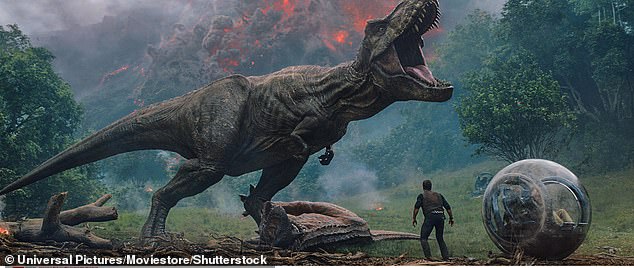
From Jurassic Park to Walking with Dinosaurs, blockbuster movies usually depict dinosaurs as terrifying beasts. Pictured: a scene from Jurassic World: Fallen Kingdom
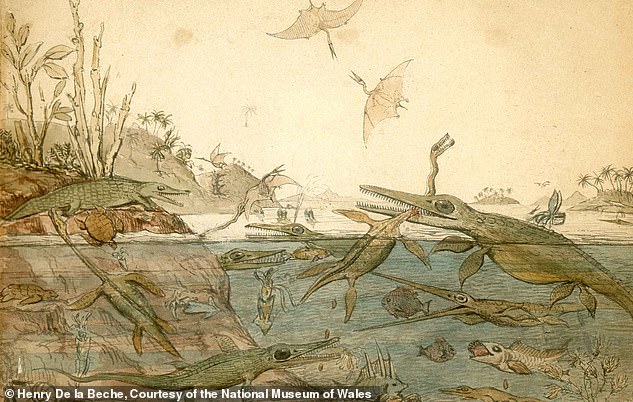
This painting, Duria Antiquor (A More Ancient Dorset), was painted in 1830 and is believed to be the first ever piece of paleoart – the depiction of life based on the fossil record
The story of the dinosaurs, or at least how we thought they looked, began on February 20, 1824.
At a meeting of the Geological Society, a scientist named William Buckland gave a lecture on fossils that had been found in Stonesfield, Oxfordshire.
His theory was that these were the bones of a now-extinct species of giant lizard, which he named the megalosaurus, literally meaning ‘great lizard’.
Now, we know that the megalosaurus was one of the largest carnivores of the middle Jurassic Era and lived about 168 million years ago.
In his lecture, he described an ‘enormous fossil animal… [with] a length exceeding 40 feet [12m] and a bulk equal to that of an elephant.’
However, modern experts believe that the megalosaurus was about 20 feet (six metres) long and walked on two legs rather than on all fours as Buckland believed.
In the 1863 illustration of an Iguanodon and a Megalosaurus below, you can see just how these animals were believed to essentially be giant lizards walking on all fours.
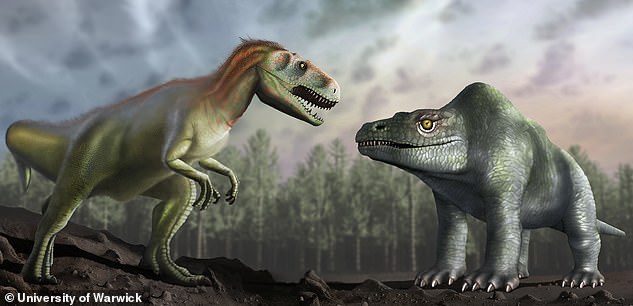
Scientists used to think that the megalosaurus walked on all fours and was 40ft long (right). Now, experts think that they were actually bipedal and only 20ft long (left)
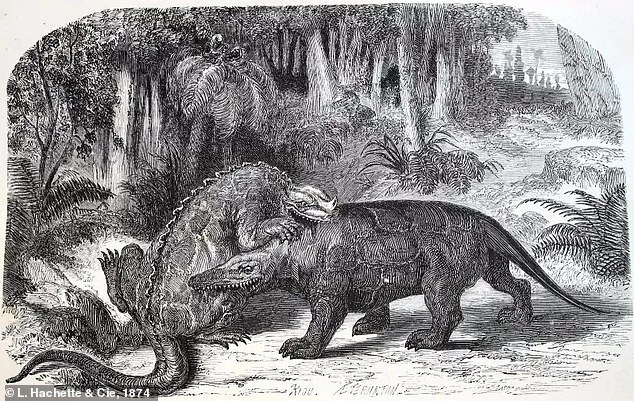
The first dinosaurs ever discovered were the megalosaurus and the iguanodon, pictured here in an 1863 illustration. Early scientists thought these animals were giant lizards, and more like scaly rhinos than how we now understand dinosaurs

Palaeontologists now think the iguanodon walked on its hind legs. The ‘horns’ that early scientists found on the body are now know to be its large thumbs
But, given that this was almost 20 years before the term dinosaur would even be coined, he was bound to get a few details wrong.
In early artistic depictions of dinosaurs, creatures like the Megalosaurus and Iguanodon look more like big scaly dogs with long, hanging tails.
You may have even seen some of these depictions for yourself in Crystal Palace Park in London.
In 1854, sculptor and paleoartist Benjamin Waterhouse Hawkins unveiled 30 statues of dinosaurs and ancient mammals in the Crystal Palace garden.
Created under the instruction of palaeontologist Richard Owen, who invented the term dinosaur, these were the first full-scale depictions of dinosaurs.
But to the modern viewer, these old statues might seem almost comical.
The iguanodon literally looks like a giant iguana, while the Megalosaurus appears more like an enormous monitor lizard.
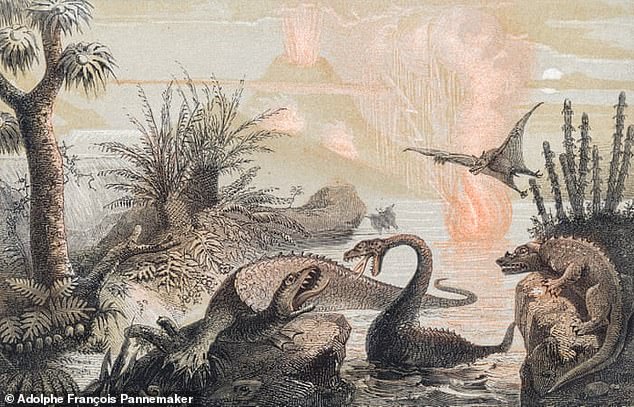
In this 1857 illustration by Adolphe François a number of dragon-like dinosaurs are fighting in the sea. In early paleoart, land-based dinosaurs are occasionally shown as being aquatic
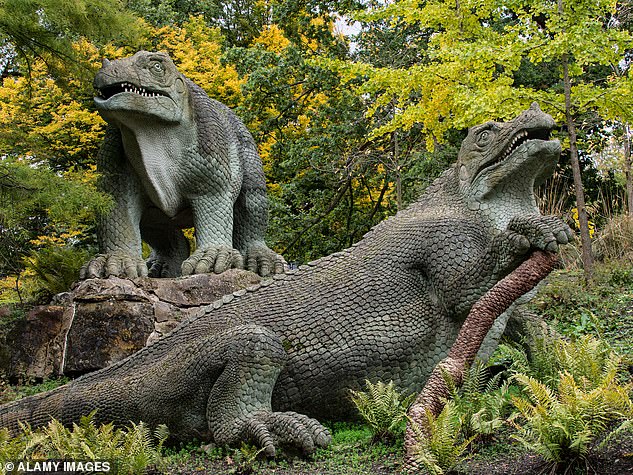
The dinosaur sculptures in Crystal Palace were created in 1854 and are the first full-scale representations of the dinosaurs. Pictured here are the iguanodon (right) and megalosaurus (left)
Dr Susannah Maidment, senior researcher at the Natural History Museum in London, explained that these strange models were based on the best evidence available at the time.
She said: ‘When Buckland found these bones he had some hip bones, a bit of limb bones, and the jaw, but that was all they had.
‘When Gideon Mantel first discovered the first iguanodon all he had was two teeth to go on.’
To try and guess what these creatures looked like Mantel and artists like Hawkins looked at living animals for inspiration.
Even as more fossils were found, the lack of complete skeletons led to some hilarious misinterpretations.
In the 1869 illustration below, the head of the Elasmosaurus is actually where its tail should be while the artist has given the Dryptosaurus too many fingers.
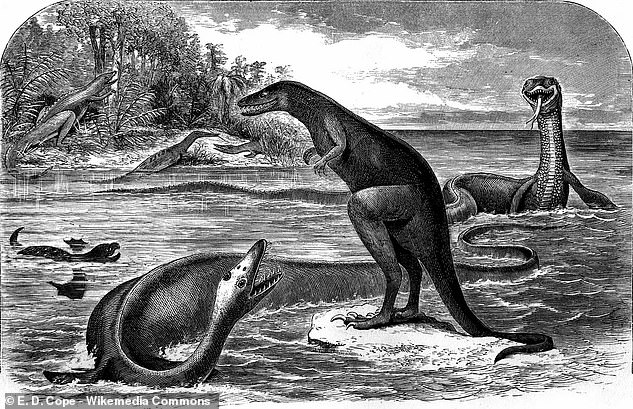
Because the fossil record was limited, paleoartists often made mistakes. In this illustration, the head of the Elasmosaurus (bottom left) is attached where its tail should be
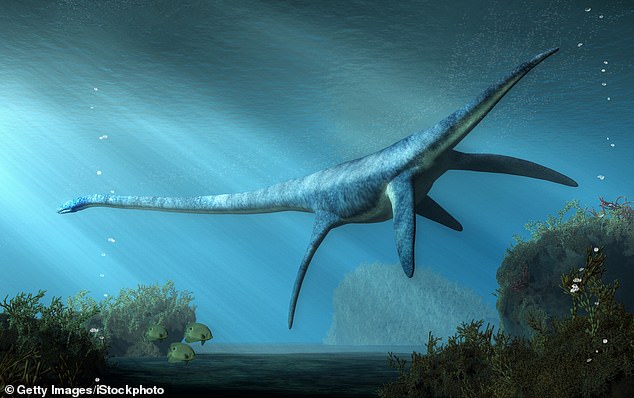
Now, experts know that the head of the Elasmosaurus would have been at the other end of its body. Experts aren’t sure why their necks were so long, but suggest it may have helped them to catch fish
Today, paleontologists have fully articulated complete skeletons to work on so we have a pretty good idea of what the basic body plans of dinosaurs were like.
But soft tissues like muscle and fat don’t survive in the fossil record, meaning paleoartists have usually been free to make dinosaurs as skinny or chunky as they see fit.
This has led to unusually large-looking megalosaurus while, in some depictions, T-rex appears to have been put on a pretty extreme diet.
But for other features, they still need to turn to dinosaurs’ living descendants – birds and crocodiles – and look at the ‘extant phylogenetic bracket’.
Professor Maidment explained: ‘We can basically look for a muscle in a crocodile and then go look for the same muscle in a bird.
‘If the bird and the crocodile both have this muscle then that probably means they inherited it from their common ancestor and therefore dinosaurs would have had it as well.’
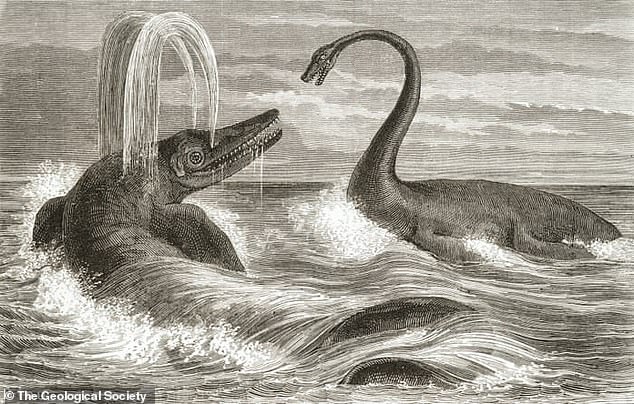
Aquatic dinosaurs like the Ichthyosaur (left) and Plesiosaur (right) were often depicted as mortal enemies battling for the sea, as in the 1863 illustration
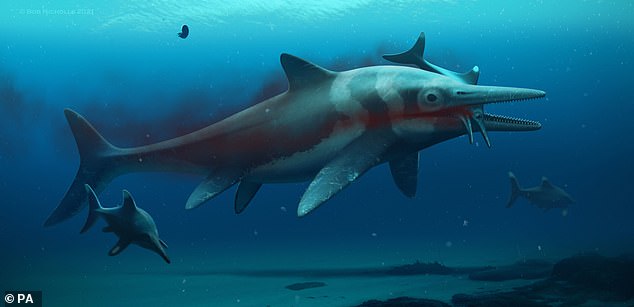
Modern palaeontologists believe that the ichthyosaur’s body was shaped more like a dolphin than a crocodile, as early researchers had thought
And, while this helps for some features, it still leaves palaeontologists in the dark when it comes to features like lips and cheeks.
Since crocodiles don’t have them we can’t know if dinosaurs did either even though it seems likely that plant eaters would need them to chew their food.
This might go some way to explaining the goofy grins that earlier paleoartists often gave dinosaurs.
Professor Steven Brusatte, a palaeontologist from the University of Edinburgh who consulted on Jurassic World: Dominion and Walking with Dinosaurs, explained that by examining the fossil record we now know much more about how dinosaurs may have looked.
But, modern palaeontologists didn’t get everything correct right away.
Professor Brusatte told MailOnline: ‘When the first dinosaurs were named and described 200 years ago, they were envisioned as overgrown reptiles that stood straight up like mammals.
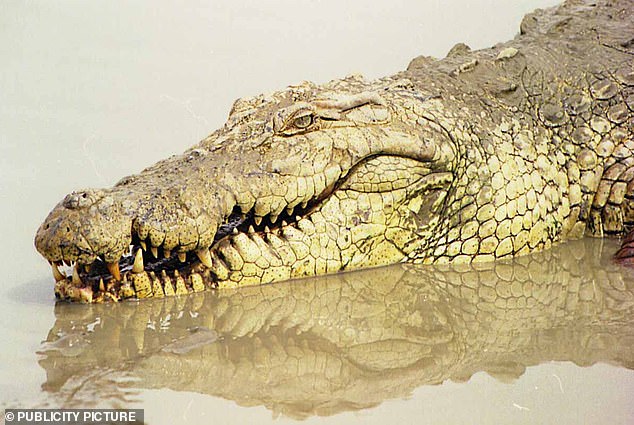
To understand how dinosaurs may have looked, researchers compare them to their surviving descendants – crocodiles and birds (stock image)
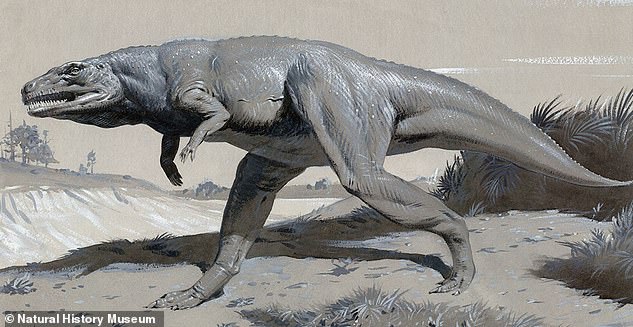
Advances in the fossil record now show that the megalosaurus (pictured) actually walked on two legs
‘Over the years, the perception changed, and dinosaurs became stereotyped as giant, slow-moving, dim-witted, scale-covered giant reptiles, like overgrown crocodiles or lizards.
‘Now we know that dinosaurs were much more athletic, energetic, and dynamic than these earlier perceptions.’
One of the biggest things that people got wrong is, famously, that dinosaurs had feathers.
The first Jurassic Park film showed dinosaurs as green or brown and scaly, but experts now say that this couldn’t be further from the truth.
Professor Brussatte said: ‘We know that many dinosaurs had feathers. This isn’t a guess, or the hallucination of mad artists and scientists.
‘We have thousands of fossils of feather-covered dinosaurs, most of them buried by a few catastrophic volcanic eruptions in China that locked in many details of their bones and feathers, kind of like how humans were overcome by volcanoes at Pompeii and set in stone.’
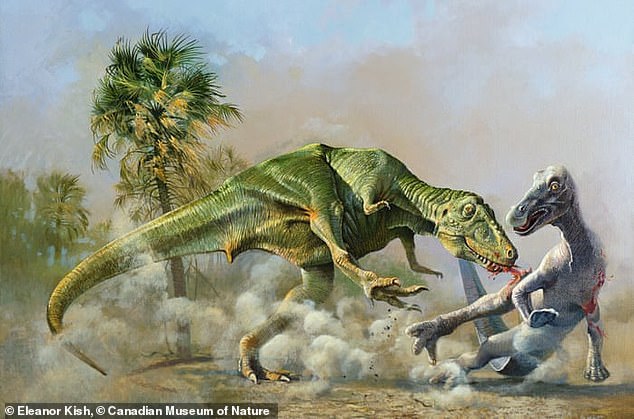
A better understanding of dinosaurs has greatly improved paleoart. In this 1976 illustration of a T-Rex (left) and an Edmontosaurus (right), the proportions are very familiar. However, since soft tissue isn’t preserved it is up to the artist to decide on the details of the muscles
He adds that it was ‘terrible timing’ that the first feathered dinosaur fossil was found just three years after the release of Jurassic Park.
While velociraptors were shown as green and scaly in the film, Professor Brusatte says they would have had ‘feathers all over its body and wings on its arms, but it probably couldn’t fly, and used its wings as display structures—advertising billboards if you will.’
Not all dinosaurs have feathers but experts now believe that many carnivorous dinosaurs would have had a thick coat of colourful feathers.
And, as for colour, scientists say we might have been getting a lot of this wrong too.
For scaly dinosaurs, it can be hard to conclusively say what colour they are, even when parts of the skin have been fossilised.
But we can actually get a fairly good idea of what colour feathered dinosaurs might be.
Dr Maitment says: ‘If you take a scanning electron microscope and look at a feather from a living bird you’ll find it has these cells called melanosomes and those hold the pigment melanin.’
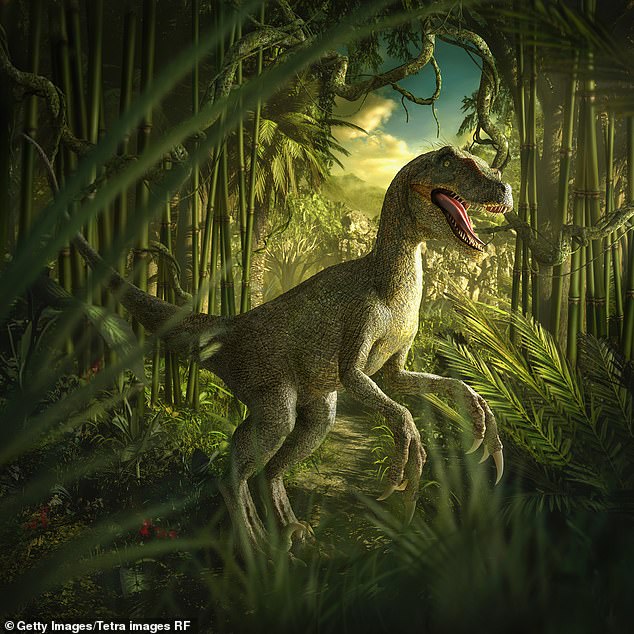
The velociraptor (pictured) has been depicted as green and scaly in numerous pieces of film and media
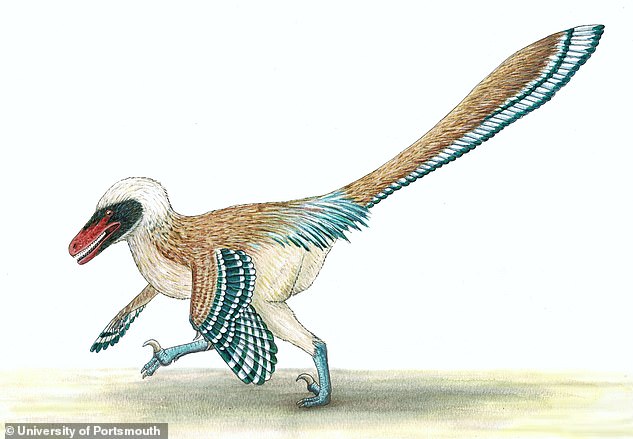
Experts now think that the velociraptor (pictured) was actually covered in a thick layer of feathers and had wings which it used for signalling
In living birds the shape of those cells actually codes for the colour of the feather, whether it is red and brown or black and grey.
And, if those cells are stacked on top of each other, this shows that the feather will be iridescent and shine, like in starlings.
What is really exciting is that if you take a fossil feather from a dinosaur and put that under an electron microscope you still find those same cells.
That means, from the shape of the melanosomes, you can work out what colour a dinosaur’s feather would be.
Palaeontologists have used this to show that, far from being uniformly drab, some dinosaurs would have had bright colours, stripes, and iridescent patterns.
And, while it is funny to see how far off our ideas about dinosaurs used to be, learning what they look like is actually very important for palaeontology.
Just like in modern animals, signalling to mates, warding off predators, and hiding with camouflage is all about colour.
Dr Emma Nicholls, collections manager at the Oxford University Museum of Natural History, told MailOnline that these debates are still ongoing among experts.
She said: ‘Did dinosaurs like Tyrannosaurus have lips or not? It matters in terms of our understanding of how they ate.
‘Another debate is over what certain structures were for, such as the sail of Spinosaurus. Was it thermoregulation, sexual display, something to do with swimming, or something else?’










